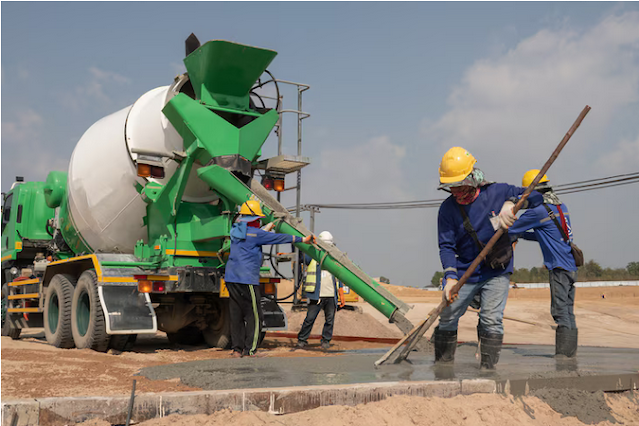Delivering Quality: How Ready-Mix Concrete Comes to Your Site
Introduction
In the world of construction, the delivery of materials to the job site is a critical element of project success. Ready-mix concrete, a versatile and essential construction material, is no exception. Understanding how ready-mix concrete is delivered to your site is vital for builders, contractors, and project managers. In this comprehensive guide, we will explore the process of ready-mix concrete delivery, from batching plants to the construction site. We will discuss the steps involved, the equipment used, and the benefits of this efficient and effective method.
The Role of Ready-Mix Concrete in Construction
Ready-mix concrete is a precisely prepared mixture of cement, aggregates (such as sand, gravel, or crushed stone), water, and, sometimes, additives. The quality and consistency of the mixture are rigorously monitored and controlled in a controlled environment at a batching plant. This ensures that the concrete meets specific strength and durability requirements. Once mixed, ready-mix concrete is transported to the construction site in specialized vehicles, such as transit mixers or concrete mixer trucks. This process of delivery is integral to construction projects of all sizes and types.
The Process of Ready-Mix Concrete Delivery
Ready-mix concrete delivery involves several stages, each critical to ensuring the quality, consistency, and timely arrival of the concrete at the construction site. Here are the key steps in the process:
Batching: The process begins at the batching plant, where the precise amounts of cement, aggregates, water, and any necessary additives are mixed according to the project's requirements. The batching plant is equipped with sophisticated equipment that measures and combines the ingredients with great accuracy.
Mixing: The mixing process is crucial in ensuring that the concrete achieves the desired consistency and properties. The mixture is agitated in a rotating drum to ensure thorough and uniform mixing. The concrete is mixed until it reaches the required quality and consistency standards.
Transportation: Once the concrete is mixed, it is immediately transported to the construction site in specialized vehicles. Two common types of concrete delivery vehicles are:
Transit Mixers: These are mobile concrete mixing vehicles equipped with rotating drums. They continuously agitate the concrete to prevent it from setting during transportation. Transit mixers are suitable for short distances and on-site mixing requirements.
Concrete Mixer Trucks: These trucks transport pre-mixed concrete from the batching plant to the construction site. The concrete is loaded into the drum at the plant and is kept in a rotating state during transit to maintain uniformity. This method is more common and suitable for longer distances.
Arrival at the Site: When the ready-mix concrete arrives at the construction site, it is crucial to have a well-organized setup in place. The construction team must be ready mix concrete delivery to receive the concrete and distribute it to the intended location promptly.
Placement: The placement of ready-mix concrete is typically done using various methods, such as pouring, pumping, or conveying. It is essential to ensure the concrete is placed accurately, without segregation, and is properly compacted to achieve the desired strength and durability.
Benefits of Ready-Mix Concrete Delivery
Quality Assurance: Ready-mix concrete is produced under strict quality control measures at the batching plant, ensuring that the mixture meets or exceeds specific quality and performance standards. This quality assurance is critical for the success and longevity of construction projects.
Time Efficiency: The delivery of ready-mix concrete significantly reduces construction time. On-site mixing can be time-consuming and prone to delays due to manual measurement and mixing. Ready-mix concrete arrives at the site in a ready-to-use state, saving valuable time.
Consistency: Consistency in the mix and quality of ready-mix concrete is guaranteed. This is essential for ensuring the structural integrity and performance of the construction project. On-site mixing can lead to variations and inconsistencies that may affect the final outcome.
Reduced Wastage: Traditional on-site mixing often results in material wastage due to inaccuracies in measurement and mixing. Ready-mix concrete minimizes such wastage, reducing costs and environmental impact.
Cost Savings: Although ready-mix concrete may appear more expensive initially, the savings it provides in terms of labor, time, and reduced wastage often outweigh the initial investment. This cost efficiency is a significant benefit for construction projects.
Environmental Responsibility: The controlled production and transportation processes of ready-mix concrete reduce environmental impact by minimizing material wastage and optimizing material usage. This aligns with the growing demand for environmentally responsible construction practices.
Conclusion
The process of delivering ready-mix concrete to construction sites is a well-orchestrated journey from batching plants to the project location. It involves precise mixing, efficient transportation, and organized placement to ensure that the concrete arrives in its intended state and is placed accurately. The benefits of ready-mix concrete delivery, including quality assurance, time efficiency, consistency, cost savings, and environmental responsibility, make it an integral part of the construction industry. By understanding and optimizing this process, construction professionals can ensure that their projects are built on a strong foundation of efficiency, quality, and sustainability.




Comments
Post a Comment